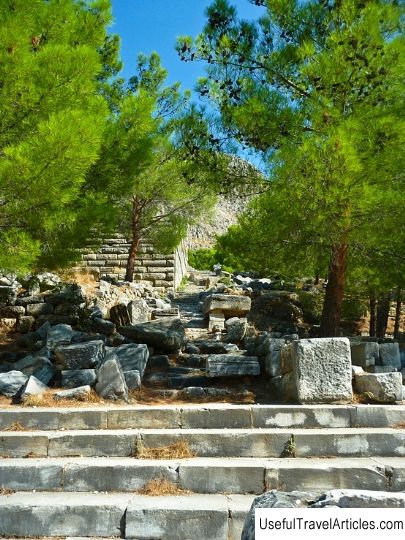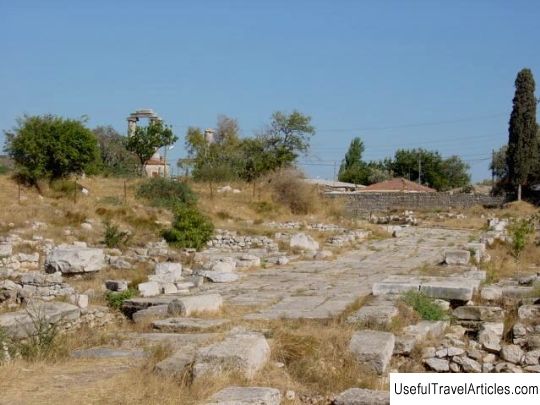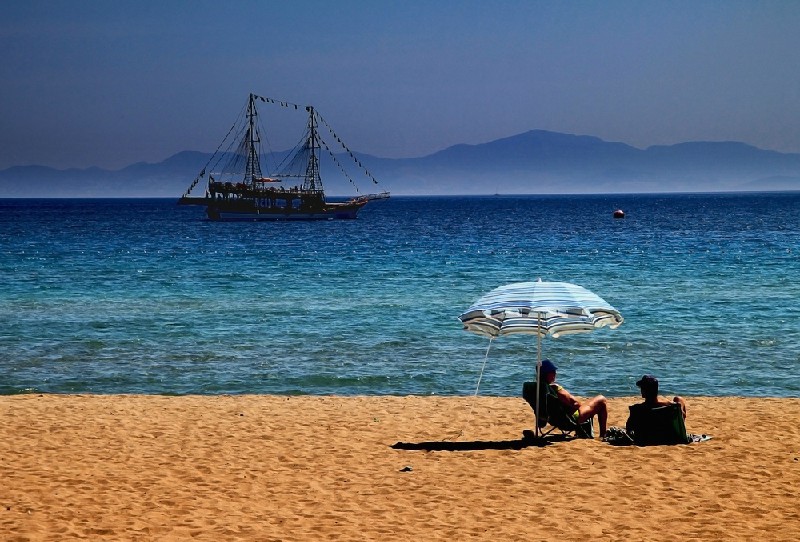Prien ancient town description and photos - Turkey: Didim
Rating: 8,2/10 (689 votes) 
Prien ancient town description and photos - Turkey: Didim. Detailed information about the attraction. Description, photographs and a map showing the nearest significant objects. The name in English is Prien ancient town. Photo and descriptionNear the Turkish resort of Didim is the ancient city of Priene, one of the twelve most famous ancient cities of Asia Minor. Polis is very well preserved to this day, and now is an excellent example of a Hellenistic city. Priene was founded in the 11th century BC by Neleus' son Epitus and is located at the foot of the Mikale hill. This Ionian city was originally located on the coast of the Gulf of Latmiya and had two harbors in which a small fleet was stationed. Priene belonged to the union of twelve Ionian cities and was located only 17 kilometers from the famous Miletus. The Meander River ran ten kilometers from the polis. However, in the middle of the 4th century, due to the deposits of this river, the coastline jutted further into the sea and the city was at a distance of several kilometers from the water line. Just at that time, Priene was being rebuilt again after the destruction by the Persians and the city had to be moved. In the third and second centuries. BC. Priene was part of the Seleucid, then Pergamon kingdoms; later it was a provincial city of the Roman Empire and Byzantium. During the years when the policy was under the rule of Byzantium, the city was the seat of the Byzantine bishop. Later, due to the strong subsidence of the soil caused by the river sediment, Priene lost its former importance. Perhaps this led to the death of the city. But there are other versions on this score. One of them claims that an earthquake was the cause of Priene's death, the other blames the malaria epidemic for everything. The city existed until the 13th century, when the attack of the Turks and the even greater retreat of the sea made it a small village. completely lost its former significance. Despite this, Priene is well preserved and practically does not contain later reconstructions, such as Ephesus. That is why it is considered one of the best ancient monuments on the Aegean coast. Priene is one of the few cities in Hellas that have brought to our time quite complete information about the urban planning of the Hellenistic era. The ruins of the city look like terraces, therefore they were the subject of detailed scientific study by the English Society of Amateurs in 1765 and 1768, and in 1895 - 1899 they were thoroughly studied by Theodor Vegand for the Berlin Museum. At the end of the 19th century, they were studied by Karl Human, who found out that the city was built up according to the system of the architect Hippodamus. Priene was divided by six streets into 80 mini-blocks, the dimensions of which were approximately 42 by 35 meters. The blocks contained four residential buildings, and the whole block was usually occupied by public buildings. The skill of the architect, who inscribed such a strict rectangular urban composition in the mountainous relief, is striking. Only in Pompeii, this scheme of the city's layout was preserved in such an intact form, but it is at least three centuries younger than the Priene one. One of the first in Priene was built an ancient theater, otherwise called the Acropolis and dating back to the 4th century BC ... In the 2nd century AD, the Romans reconstructed it, in particular, they rebuilt the stage. The theater is located at the very top of one of the spurs of the mountain, at the base of which the ancient city is located. From here a magnificent view of the surroundings opens. The theater is shaped like a horseshoe in the classic Hellenic style and is small in size. Its highlight is that in the center there is an altar that was previously used for sacred offerings to Dionysus. Initially, the theater had 50 tiers of benches and could accommodate 50 thousand spectators, and the stage was 18 meters long. The most striking feature of the building is the presence of five large marble thrones for local dignitaries. The theater is perfectly preserved. Behind the building you can see the ruins of a Byzantine basilica. Priene's most famous monument is the Temple of Athena, which is located against the backdrop of a sheer cliff and is visible from a great distance. It was built according to the project of the architect Pytheas, who was also the author of the Mausoleum at Halicarnassus. The temple was dedicated to Athena Polias, which translates as "keeper of the city." The construction of the temple began in the middle of the fourth century BC, when Alexander the Great liberated Priene from Persian rule. It was he who allocated money for the construction of the temple of Athena. The inscription with the dedication of the temple by Alexander the Great has been preserved in the British Museum in the form of fragments of a huge cult statue of the goddess. The construction took about two centuries. The length and width of the base of the temple are approximately 37 and 20 meters. A colonnade of 6 rows of 11 columns surrounded the temple, but only five Ionic columns have survived to this day. The proportions and methods of building the temple were used as standard even in Roman times, when the structure was rededicated to Athena Polias and Augustus, the new Roman emperor. At that time, all the existing sanctuaries and temples of Priene were adapted to accommodate busts and statues of the emperor, his family and ancestors. In front of the temple of Athena, the ruins of a magnificent altar have been preserved. On the highest terrace of the city, just north of the temple, are the sanctuaries of Demeter and Cora, which are one and a half to two centuries older than any other structure in the city. And a little below the temple of Athena is the center of the city's life - Agora (shopping area). It dates back to the 3rd century BC. In its northern part there is a sacred hall 16 meters long, and on three sides it is bordered by columnar porticoes. Nearby is the Buleuterium (parliament building), designed for 640 people, next to which there is a place for the sacred fire - the pretapeon. The Temple of Olympian Zeus is located in the eastern part of the agora, and the market in the western. On both sides of the road that connects the agora with the western gate, there are once rich residential buildings, the walls of some of them are up to 1 5 meters. Recently found staircases of houses prove that in ancient times they had at least two floors. In addition, in Priene you can see the ruins of the gymnasium, the stadium and the thermae, which are in rather poor condition.        We also recommend reading Tandjung Uban description and photos - Indonesia: Bintan Island Topic: Prien ancient town description and photos - Turkey: Didim. |




